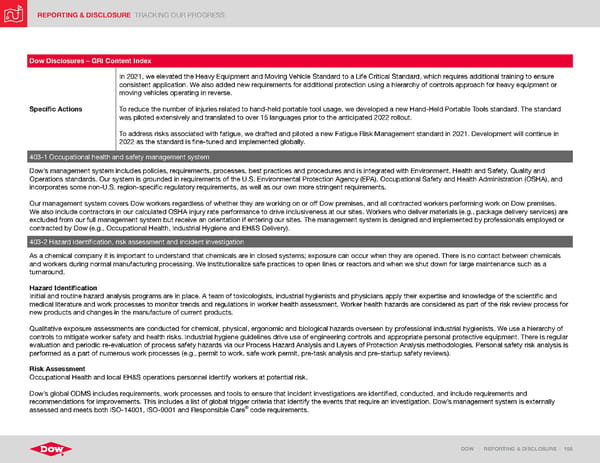REPORTING & DISCLOSURE TRACKING OUR PROGRESS DOW | REPORTING & DISCLOSURE | 158 Dow Disclosures – GRI Content Index Specific Actions In 2021, we elevated the Heavy Equipment and Moving Vehicle Standard to a Life Critical Standard, which requires additional training to ensure consistent application. We also added new requirements for additional protection using a hierarchy of controls approach for heavy equipment or moving vehicles operating in reverse. To reduce the number of injuries related to hand-held portable tool usage, we developed a new Hand-Held Portable Tools standard. The standard was piloted extensively and translated to over 15 languages prior to the anticipated 2022 rollout. To address risks associated with fatigue, we drafted and piloted a new Fatigue Risk Management standard in 2021. Development will continue in 2022 as the standard is fine-tuned and implemented globally. 403-1 Occupational health and safety management system Dow’s management system includes policies, requirements, processes, best practices and procedures and is integrated with Environment, Health and Safety, Quality and Operations standards. Our system is grounded in requirements of the U.S. Environmental Protection Agency (EPA), Occupational Safety and Health Administration (OSHA), and incorporates some non-U.S. region-specific regulatory requirements, as well as our own more stringent requirements. Our management system covers Dow workers regardless of whether they are working on or off Dow premises, and all contracted workers performing work on Dow premises. We also include contractors in our calculated OSHA injury rate performance to drive inclusiveness at our sites. Workers who deliver materials (e.g., package delivery services) are excluded from our full management system but receive an orientation if entering our sites. The management system is designed and implemented by professionals employed or contracted by Dow (e.g., Occupational Health, Industrial Hygiene and EH&S Delivery). 403-2 Hazard identification, risk assessment and incident investigation As a chemical company it is important to understand that chemicals are in closed systems; exposure can occur when they are opened. There is no contact between chemicals and workers during normal manufacturing processing. We institutionalize safe practices to open lines or reactors and when we shut down for large maintenance such as a turnaround. Hazard Identification Initial and routine hazard analysis programs are in place. A team of toxicologists, industrial hygienists and physicians apply their expertise and knowledge of the scientific and medical literature and work processes to monitor trends and regulations in worker health assessment. Worker health hazards are considered as part of the risk review process for new products and changes in the manufacture of current products. Qualitative exposure assessments are conducted for chemical, physical, ergonomic and biological hazards overseen by professional industrial hygienists. We use a hierarchy of controls to mitigate worker safety and health risks. Industrial hygiene guidelines drive use of engineering controls and appropriate personal protective equipment. There is regular evaluation and periodic re-evaluation of process safety hazards via our Process Hazard Analysis and Layers of Protection Analysis methodologies. Personal safety risk analysis is performed as a part of numerous work processes (e.g., permit to work, safe work permit, pre-task analysis and pre-startup safety reviews). Risk Assessment Occupational Health and local EH&S operations personnel identify workers at potential risk. Dow’s global ODMS includes requirements, work processes and tools to ensure that incident investigations are identified, conducted, and include requirements and recommendations for improvements. This includes a list of global trigger criteria that identify the events that require an investigation. Dow’s management system is externally assessed and meets both ISO-14001, ISO-9001 and Responsible Care ® code requirements.
 ESG Report | Dow Page 157 Page 159
ESG Report | Dow Page 157 Page 159